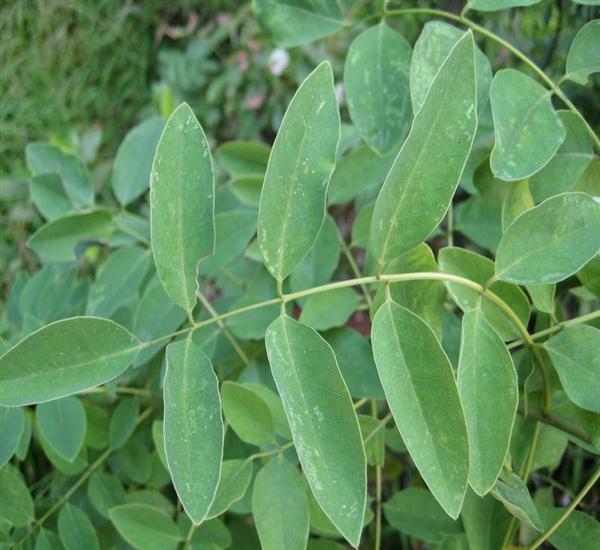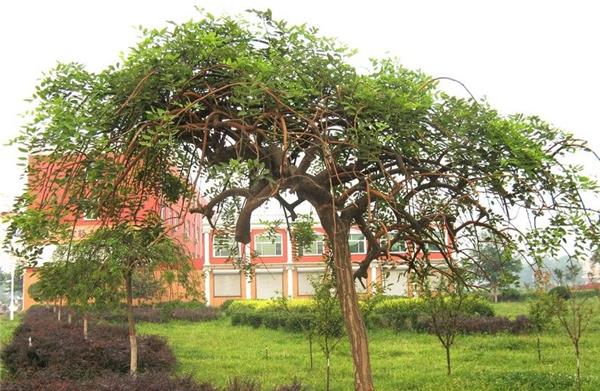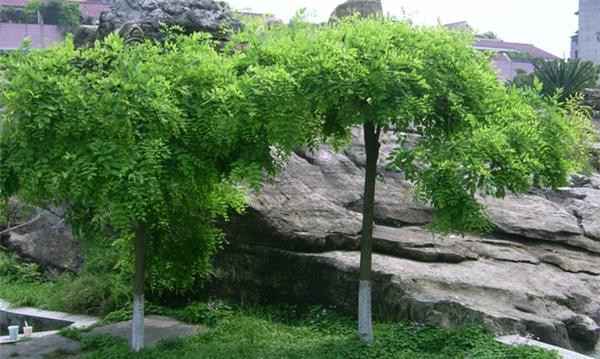Attention should be paid to three important links in the cultivation and maintenance of Robinia pseudoacacia
The nature of Robinia pseudoacacia is relatively strong, and it generally suffers from fewer diseases and insect pests, and there is only one kind of leaf disease that is common. It is relatively easy to plant and maintain, and it is suitable for planting in the courtyard.

1. Grafting seedling technique of Robinia pseudoacacia
1. Preparation work: in spring, seedlings with DBH above 5 cm are selected in the nursery and left 1.5-2.5 m to dry. When the new branches grow to about 10cm, 6-8 branches with different directions and uniform distribution are selected. The rest is erased from the base. These branches are best concentrated within the range of 10cm at the height of the trunk. Can be adjacent to the vacancy of the branches left leeway 5cm re-heart to meet the requirements.
2. Transplanting: at the end of March and the beginning of April of the second year, transplanting with soil was carried out according to the row spacing of 1.5m × 2m. After transplanting, it was watered and waited for grafting.
3. Grafting: in the first and middle of April. Scion selection: choose the surrounding branches of the dragon claw locust line tree, which is graceful and disease-free. The collection of branches can be combined with the pruning of the mother tree. First, on the smooth part of the base of the rootstock branch, 5-15cm away from the base, then cut upward gradually to the xylem, and finally cut out an oval interface with a length of about 2-3cm. Enter the knife around the lower part of the full bud in the middle of the scion, cut it up step by step, and reach the xylem, and cut the oval bud plate around the 1cm above the bud. The length, width and width of the bud are slightly smaller than the interface of the rootstock. Put the sprouts on the rootstock and align the four sides. Then wrap it with plastic film.

2. Pruning techniques of Robinia pseudoacacia
The main results are as follows: 1. Dormant pruning is generally carried out after falling leaves in autumn to before germination in the following spring. The principle of pruning is to make several side branches radiate evenly around to form a good umbrella-shaped skeleton. The overlapping branches should be removed from the base, and the introverted branches should also be removed, and then the diseased branches should be cut off. All the extended branches are truncated, leaving 4-5 buds. The foremost buds should be full lateral buds, which can ensure that the lateral branches are wavy and one arch after another to enlarge the crown. The thin and weak branches of the bore should also be cut off. After pruning, the whole crown structure is clearly primary and secondary, and there are many but not chaotic.
2. Summer pruning is the supplement and continuation of winter pruning. In the vigorous growth period of late spring and early summer, often at the top of the umbrella crown, the buds on the back of the side branches developed into thick overgrown branches, standing upright, destroying the umbrella crown. Therefore, the overlapping branches and over-dense branches formed by improper lateral buds during winter pruning should be cut off. For drooping branches, because of their different growth, it will also form uneven length, it is best to determine the same level height and trim neatly. You can always maintain a good umbrella crown.

3. Control of edge leaf disease of Robinia pseudoacacia
The main results are as follows: 1. Bacterial ☆ banned ☆ disease: most of the disease occurred from the edge of the outer leaf or heart leaf, yellowed along the leaf edge to the petiole, and brown necrotic patches appeared at the leaf edge. With the development of the disease, the edge of the diseased leaf became scorched, the leaf color became pale, and finally all of them wilted and died. In the case of more water loss of leaves, the pathogen infected from the leaf edge, causing pathological changes and necrosis of parasitic leaves, and gradually developed and spread.
2. Calcitonin malnutrition: calcium in plants can form insoluble calcium salts and precipitate, which is an element that can no longer be used. Therefore, the symptoms of calcium deficiency are often manifested in newborn tissues. After the occurrence of leaf scorch disease, brown spots appear on the edge of the lateral leaf or heart leaf, and when severe, the ring dies and dries up.
Prevention and control methods:
The main results are as follows: 1. the function of protecting the root system is normal, the relative humidity should not be too high for a long time, and try to keep the humidity normal.
2. Spraying foliar fertilizer such as Huimanfeng, promoting Fengbao and ensuring bumper harvest has a certain effect.
3. If there is bacterial infection, you can spray agents to control bacterial ☆ banned ☆ diseases, such as Jiarinong (47% Chunlei king copper wettable powder) 1000 times solution, green Debao, copper noble (30% copper sulfate suspension) 400x solution, can kill (53.8% copper hydroxide dry suspension) 500x solution and so on.

Generally speaking, Robinia pseudoacacia is more suitable for planting in the courtyard, but now there are many dwarf varieties that can be cultivated in pots. Robinia pseudoacacia is the first choice for ornamental plants because of its unique tree shape, elegant color and fragrant flowers.
Related
- Wuhan Hospital Iron Tree Blooming Result Was Instantly Frightened by the Gardener Master
- Which variety of camellia is the most fragrant and best? Which one do you like best?
- What is the small blue coat, the breeding methods and matters needing attention of the succulent plant
- Dormancy time and maintenance management of succulent plants during dormancy
- Minas succulent how to raise, Minas succulent plant pictures
- What are the varieties of winter succulent plants
- How to raise succulent plants in twelve rolls? let's take a look at some experience of breeding twelve rolls.
- Attention should be paid to water control for succulent plants during dormant period (winter and summer)
- Watering experience of twelve rolls of succulent plants
- Techniques for fertilizing succulent plants. An article will let you know how to fertilize succulent plants.



